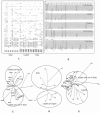Comparing genomes of Helicobacter pylori strains from the high-altitude desert of Ladakh, India
- PMID: 15814963
- PMCID: PMC1081395
- DOI: 10.1128/JCM.43.4.1538-1545.2005
Comparing genomes of Helicobacter pylori strains from the high-altitude desert of Ladakh, India
Erratum in
- J Clin Microbiol. 2005 Jul;43(7):3586
Abstract
The genomic diversity of Helicobacter pylori from the vast Indian subcontinent is largely unknown. We compared the genomes of 10 H. pylori strains from Ladakh, North India. Molecular analysis was carried out to identify rearrangements within and outside the cag pathogenicity island (cag PAI) and DNA sequence divergence in candidate genes. Analyses of virulence genes (such as the cag PAI as a whole, cagA, vacA, iceA, oipA, babB, and the plasticity cluster) revealed that H. pylori strains from Ladakh are genetically distinct and possibly less virulent than the isolates from East Asian countries, such as China and Japan. Phylogenetic analyses based on the cagA-glr motifs, enterobacterial repetitive intergenic consensus patterns, repetitive extragenic palindromic signatures, the glmM gene mutations, and several genomic markers representing fluorescent amplified fragment length polymorphisms revealed that Ladakhi strains share features of the Indo-European, as well as the East Asian, gene pools. However, the contribution of genetic features from the Indo-European gene pool was more prominent.
Figures


References
-
- Achtman, M., T. Azuma, D. E. Berg, Y. Ito, G. Morelli, Z. J. Pan, S. Suerbaum, S. Thompson, A. van der Ende, and L. J. van Doorn. 1999. Recombination and clonal groupings within Helicobacter pylori from different geographical regions. Mol. Microbiol. 32:459-470. - PubMed
-
- Ahmed, N., A. A. Khan, A. Alvi, S. Tiwari, C. S. Jyothirmayee, F. Kauser, M. Ali, and C. M. Habibullah. 2003. Genomic analysis of Helicobacter pylori from Andhra Pradesh, South India: molecular evidence for three major genetic clusters. Curr. Sci. 85:101-108.
-
- Ando, T., R. M. Peek, D. Pride, S. M. Levine, T. Takata, Y. C. Lee, K. Kusugami, A. van der Ende, E. J. Kuipers, J. G. Kusters, and M. J. Blaser. 2002. Polymorphisms of Helicobacter pylori HP0638 reflect geographic origin and correlate with cagA status. J. Clin. Microbiol. 40:239-246. - PMC - PubMed
-
- Atherton, J. C., P. Cao, R. M. J. Peek, M. K. Tummuru, M. J. Blaser, and T. L. Cover. 1995. Mosaicism in vacuolating cytotoxin alleles of Helicobacter pylori. Association of specific vacA types with cytotoxin production and peptic ulceration. J. Biol. Chem. 270:17771-17777. - PubMed
-
- Carroll, I. M., N. Ahmed, S. M. Beesley, A. A. Khan, S. Ghousunnissa, C. A. O'Morain, and C. J. Smyth. 2003. Fine-structure molecular typing of Irish Helicobacter pylori isolates and their genetic relatedness to strains from four different continents. J. Clin. Microbiol. 41:5755-5759. - PMC - PubMed
Publication types
MeSH terms
Substances
Associated data
- Actions
- Actions
- Actions
- Actions
- Actions
- Actions
- Actions
- Actions
- Actions
- Actions
- Actions
- Actions
- Actions
- Actions
- Actions
- Actions
- Actions
- Actions
- Actions
- Actions
- Actions
- Actions
LinkOut - more resources
Full Text Sources
Research Materials

